We may not have the course you’re looking for. If you enquire or give us a call on + 1-866 272 8822 and speak to our training experts, we may still be able to help with your training requirements.
Training Outcomes Within Your Budget!
We ensure quality, budget-alignment, and timely delivery by our expert instructors.
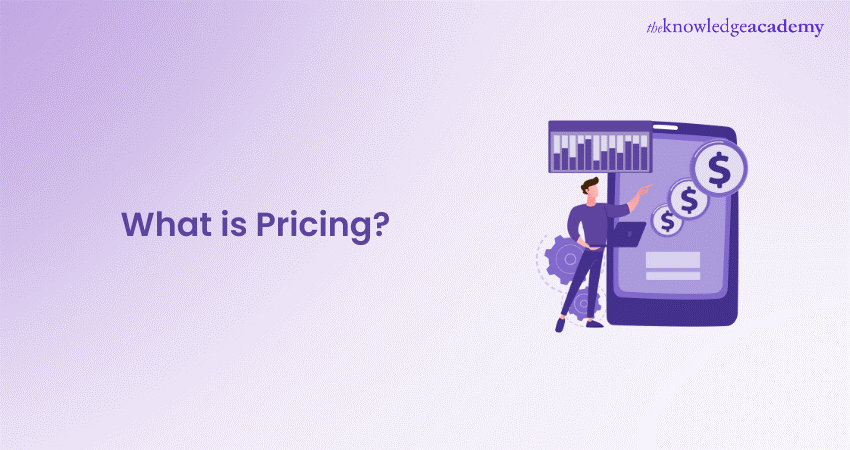
Understanding “What is Pricing” is like deciphering the secret language of business success. It’s not just about assigning a number to a product or service; it’s about crafting a narrative that aligns with your customers’ needs, desires, and perceptions. Imagine it as tuning a musical instrument—each note must be perfect to create harmony. Mastering this art means you’re not merely selling a product but delivering value that deeply resonates with your audience.
Exploring “What is Pricing” unveils a myriad of strategies that can revolutionise your business's customer engagement. Let’s delve into the various aspects of Pricing and discover how you can leverage its power to make a lasting impact in your market.
Table of Contents
1) Understanding What is Pricing?
2) Importance of Pricing
3) Key Considerations for Pricing Setup
4) Key Factors Influencing Pricing Decisions
5) Examples of Pricing
6) Conclusion
Understanding What is Pricing?
Pricing is so much more than just setting a number on a product or service—it’s a thoughtful process that balances value and market conditions. Essentially, it’s about deciding how much a customer should pay based on several factors. You need to consider how much it costs to produce or offer what you're selling, what customers are willing to pay, and what similar products or services are priced at.
Pricing concerns the determination of what customers need to pay for a certain product or service that adds value to their lives. It is both a science and an art since there are lots of considerations to make for the price to correctly depict its value and market conditions. Pricing seeks to find a certain balance whereby it may attract customers while at the same time ensuring the attainment of financial goals set by the business.
Importance of Pricing
Proper Pricing can make your business more lucrative and shore up advantages in the market. The effective Pricing will help to:
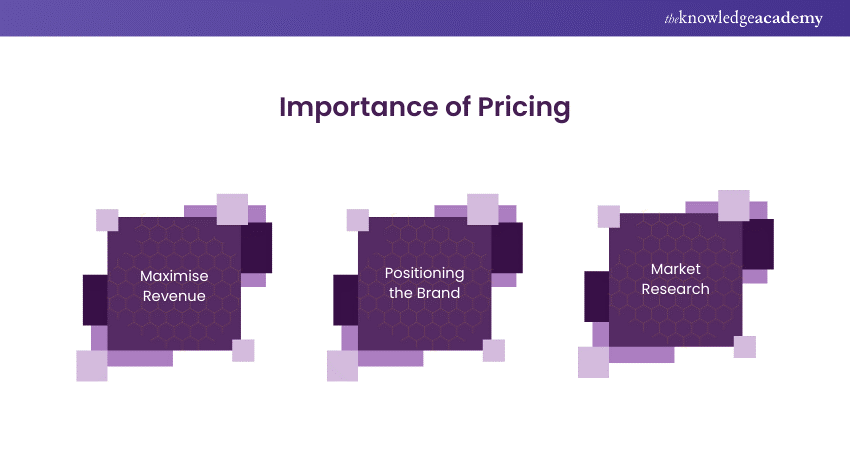
1) Maximise Revenue: The first goal of Pricing is to ensure revenue is maximised. A well-set price leads to heightened sales volume and improved profit margins. On the other side, if the price is poorly set, it may deter customers or erode profit margins, affecting the business's financial health.
2) Positioning the Brand: Price acts as an indicator about the positioning of the brand. For instance, luxury brands take the high Pricing approach in general to denote exclusivity and the best possible quality, while the budget brands choose lower Pricing levels to cater to price-sensitive customers.
3) Business Objectives: Pricing strategies are set to realise various business objectives. For example, a firm can use a penetration price to gain substantial market share in the shortest period or use a premium price in a differentiated product offering to realise maximum profits.
Key Considerations for Pricing Setup
Setting the right price involves a delicate balance between many issues. The following section examines some of the most relevant factors in detail:
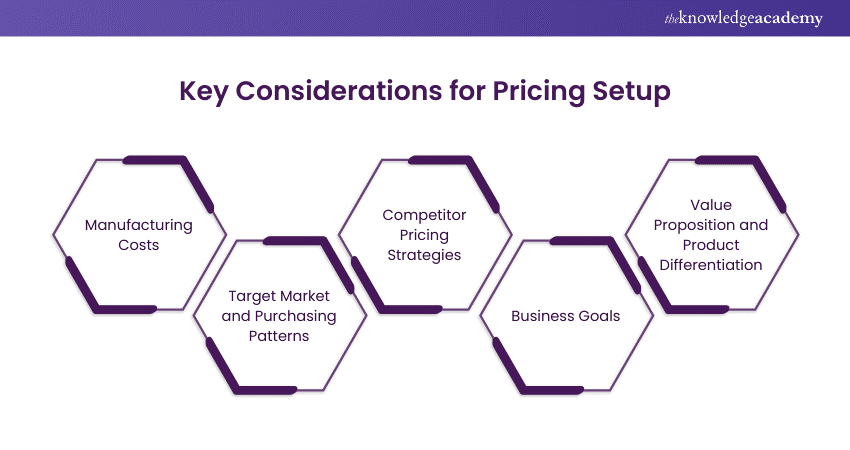
1) Manufacturing Costs
Cost of production is one of the bases of Pricing anything. The constituents of manufacturing cost are listed below:
a) Raw Materials: The cost of materials needed to produce it.
b) Labour: Salaries and benefits of the labour forces involved in its production.
c) Overheads: Utility, rent, and equipment costs.
The ability of the price to cover these costs with a profit margin therein is important for business sustainability. Knowing these costs helps in price setting in such a way that it covers the expenses as well as supports profitability.
2) Target Market and Purchasing Patterns
Knowing your target audience is of the essence to have effective Pricing. Consider:
a) Price Sensitivity: How sensitive is your audience to any change in prices? Knowing this will help in setting a price that meets their expectations without deterring potential sales.
b) Purchasing Habits: What influences their buying decisions? For example, some might be totally influenced by discounts and promotions, while others would gladly pay for convenience or quality.
Setting the right price to meet expectations and behaviour of the targeted customers will help in winning and maintaining customers.
3) Competitor Pricing Strategies
By analysing the Pricing strategies of competitors, the following can be deciphered:
a) Market Trend: By observing the competitors, one could trace the trend and accordingly price their product or service competitively.
b) Pricing Gaps: Identifying gaps in competitors’ Pricing can offer opportunities to differentiate your Pricing strategy.
Knowing how competitors' price their products or services will give them an idea for setting a proper market price in which to set themselves apart.
4) Business Goals
Your Pricing strategy should be in harmony with other broader business objectives, which are:
1) Market Penetration: In the event of entry into new markets, perhaps there might be some initial low price to gain quick penetration of customers.
2) Revenue Maximisation: The largest possible profit margins will be achieved for established markets, and thus, a Pricing strategy that maximises this might be in order.
3) Market Development: Price adjustment may also be used to meet the requirements of any new market segments or regions. Such price adjustment could lead to market development.
Alignment of Pricing with your business objectives would ensure value is retained towards a bigger strategic goal.
5) Value Proposition and Product Differentiation
The perceived value of your product or service influences Pricing:
1) Differentiators: Products with differentiators in terms of their features or benefits require a price premium.
2) Brand Equity: High brand equity allows one to focus on premium Pricing because people pay more for well-recognised or prestigious brands.
Clearly articulating value and benefits associated with your offering provides price justification and equates to customer willingness to pay.
Unlock Pricing Secrets! Join our Costing and Pricing Training and Master the Art of Setting Perfect Prices - Start now.
Key Factors Influencing Pricing Decisions
Pricing decisions don’t happen in a vacuum; they’re shaped by various external and internal factors. Here’s a closer look at what influences your Pricing strategy:
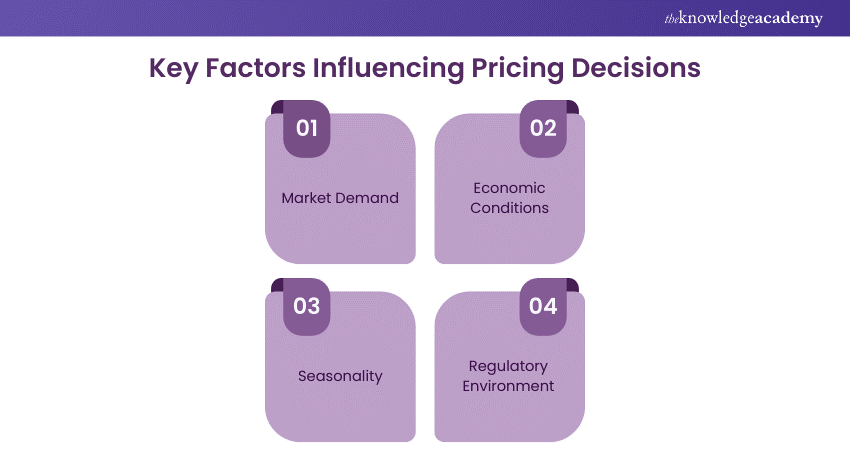
1) Market Demand: If the demand of your products is high in the market, then you increase your rates because people will pay a premium price. And if it is low, you must decrease prices to attract buyers and push the volume of sales higher. It's all about understanding and responding to the signals of the market.
2) Economic Conditions: This is the broader economic setting that has a bearing. During periods of inflation, costs rise, and consumers may cut down on spending; it may reduce what they are willing or can afford to pay. In a recession, you may have to lower prices to remain competitive and lure customers who are on strained budgets.
3) Seasonality: The demand for some products peaks in season, such as holiday decorations and summer clothes. You will want to price higher during those high seasons of the year so that the market will have more interest in your product. Lower the prices or give some discounts during the off-season to keep the sales and clear your inventories.
4) Regulatory Environment: Pricing can also be determined by regulatory factors. Price controls, taxes, or tariffs might be legislated to affect how much you can charge. It is important to keep current with relevant legislation about the appropriateness of your Pricing strategy.
Examples of Pricing Strategies
Different Pricing strategies will accomplish different things. Here are a few examples:
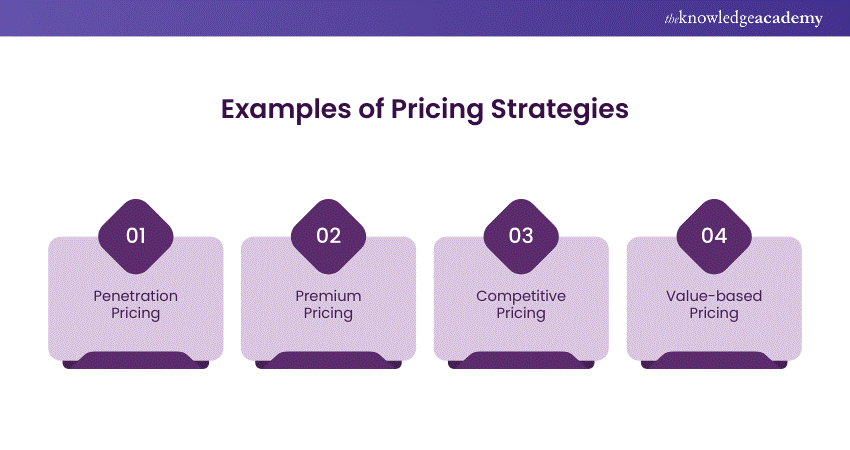
1) Penetration Pricing: A coffee shop opens its doors with relatively low prices to attract consumers and build a loyal clientele; then as their status in the market improves, they raise the price over time.
2) Premium Pricing: Luxury brands, such as Rolex, use high prices to convey exclusivity and quality. The high price has brand prestige tagged to it.
3) Competitive Pricing: The supermarket chains will also revise the prices to meet or exceed their competitors. This helps to capture and hold market share, especially for those who believe in shopping based on prices.
4) Value-based Pricing: In technology companies, Pricing of software can be based on its value to the end user. For instance, a tool saving or increasing productivity might fetch a higher price because it brings value when used.
Transform your Business Impact! Join our Business Sustainability Course and Turn Green Goals into Real Gains.
Conclusion
Pricing is one aspect of business strategy that's in constant evolution; it must be aware of the cost, market conditions, and customer perceptions. Considering these factors and following this blog on “What is Pricing", you can enhance the performance of your business. Let that sink in - The right Pricing strategy is not a question of mere numbers; here the value is added, and Pricing needs to be integrated with the general objectives of the business.
Ready to Lead? Join our Management Courses and Become the Leader You’re Meant to be – Register now!
Frequently Asked Questions

The four key Pricing considerations are manufacturing costs, target audience and their buying behaviour, competitors’ Pricing strategies, and business goals. Each factor helps ensure your price covers costs, aligns with market expectations, and supports your objectives.

The four major Pricing methods are cost-plus Pricing (adding a markup to costs), competitive Pricing (aligning with competitors), value-based Pricing (based on perceived value), and penetration Pricing (setting a low price to enter the market). Each method serves different strategic goals.

The Knowledge Academy takes global learning to new heights, offering over 30,000 online courses across 490+ locations in 220 countries. This expansive reach ensures accessibility and convenience for learners worldwide.
Alongside our diverse Online Course Catalogue, encompassing 19 major categories, we go the extra mile by providing a plethora of free educational Online Resources like News updates, Blogs, videos, webinars, and interview questions. Tailoring learning experiences further, professionals can maximise value with customisable Course Bundles of TKA.

The Knowledge Academy’s Knowledge Pass, a prepaid voucher, adds another layer of flexibility, allowing course bookings over a 12-month period. Join us on a journey where education knows no bounds.

The Knowledge Academy offers various Management Courses, including the Management Training for New Managers Course, and the Introduction to Management Course. These courses cater to different skill levels, providing comprehensive insights into Top Budgeting Skills.
Our Business Skills Blogs cover a range of topics related to Management, offering valuable resources, best practices, and industry insights. Whether you are a beginner or looking to advance your Management skills, The Knowledge Academy's diverse courses and informative blogs have got you covered.
Upcoming Accounting and Finance Resources Batches & Dates
Date
 Costing and Pricing Training
Costing and Pricing Training
Fri 10th Jan 2025
Fri 14th Feb 2025
Fri 11th Apr 2025
Fri 23rd May 2025
Fri 8th Aug 2025
Fri 26th Sep 2025
Fri 21st Nov 2025







 Top Rated Course
Top Rated Course



 If you wish to make any changes to your course, please
If you wish to make any changes to your course, please


